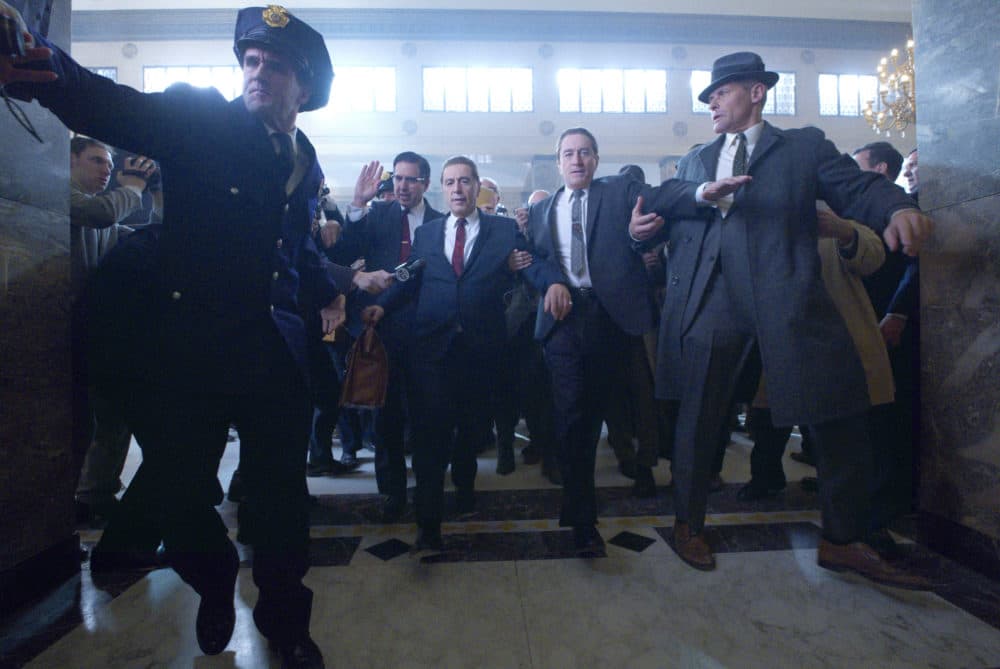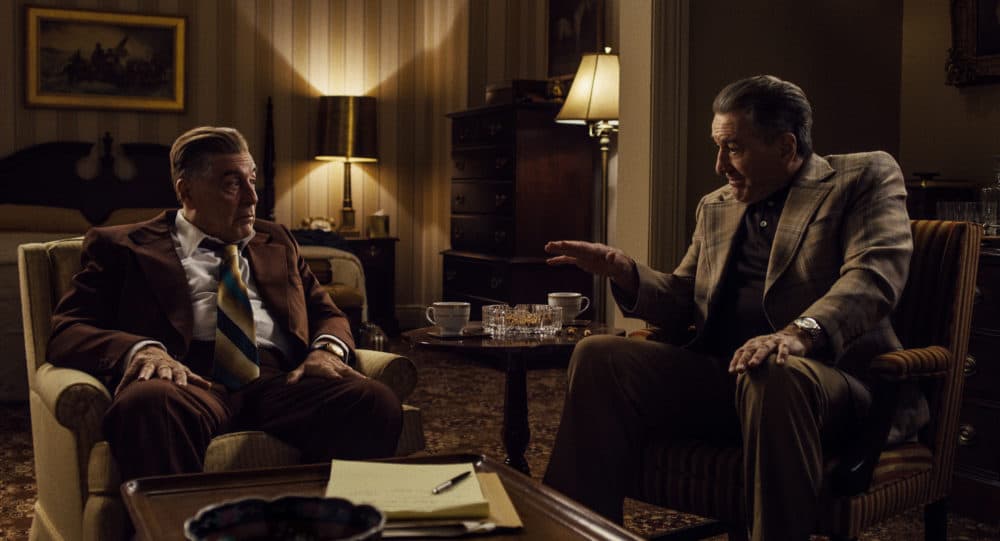Advertisement
Review
Martin Scorsese's 'The Irishman' Is A Gangster Movie To End All Gangster Movies

The cruelest joke in “The Irishman” is its opening. The sweet doo-wop sound of The Five Satins’ “In the Still of the Night” fills the soundtrack as we watch one of Martin Scorsese’s trademark tracking shots maneuvering down a hallway. It’s the same camera choreography that ushered Henry and Karen Hill into the Copacabana and all the glitz and glamour of a gangster’s life in the director’s 1990 masterpiece “Goodfellas.” Except now we’re in a nursing home, moving past the orderlies and invalids until the lens lands on Robert De Niro’s elderly, unkempt Frank Sheeran in a wheelchair. He begins babbling in voice-over narration, something about painting houses. Then he looks straight at us and begins speaking aloud.
It turns out “painting houses” is mob slang for a hit, presumably in reference to blood spattering on the walls, which is something we see an awful lot of in “The Irishman.” Scorsese’s three-and-a-half-hour magnum opus — which reunites him with longtime collaborators Robert De Niro and Joe Pesci for the first time since 1995’s “Casino” — is a gangster movie to end all gangster movies, akin to Clint Eastwood’s “Unforgiven” and John Ford’s “The Man Who Shot Liberty Valance” in that it finds a filmmaker reflecting on the genre he helped define, issuing what feels like his final word on the subject. Sprawling, enthralling and often hilarious when it isn’t busy being deeply, unfathomably sad, “The Irishman” is a career capstone for its creators, summing up 40-odd years of movies about masculinity in crisis and the wages of sin.
Spanning five decades, the film follows Frank’s ascension from low-level street hood to trusted enforcer for Pennsylvania mob boss Russell Bufalino, played by Pesci in a performance of great gravitas and terrifying stillness. The actor, who had to be cajoled out of retirement by Scorsese to take the role, is a sorely missed screen presence of electric volatility, but you’ve never seen him like this. Bufalino is the movie’s silent, seething center, measuring his words carefully and never once raising his voice. He’s got the kind of presence that makes an entire room fall quiet the moment he walks in, and I think Pesci had to come back to work for this one because there’s no other actor who could be so scary while making a salad.

Sheeran’s muscle work for the Teamsters union soon puts him in the good graces of labor leader Jimmy Hoffa, played to the hilt in a glorious, barn-burning turn by Al Pacino. (This is somehow the godfather’s first Scorsese picture, though the two did try to team up on a Modigliani biopic back in the ‘80s, and the fact they couldn’t find the financing for it makes me feel personally robbed.) Pacino doesn’t look anything like Jimmy Hoffa, but he brings an explosively funny stubbornness and a wild, self-aggrandizing theatricality that works like a pressure release valve to the more severe, understated work being done here by De Niro and Pesci. (After the New York Film Festival screening, an old professor of mine asked what my favorite scene was. I answered, “every scene with Al Pacino.”)
Once Sheeran becomes Hoffa’s bodyguard and best friend, the movie treats us to a bevy of sidesplitting sequences of these two on the road, sharing hotel rooms and bickering in their pajamas like an old married couple. This is the De Niro and Pacino “Mutt and Jeff” team-up we’ve always dreamed about. Strange that such a mournful movie should also have some of Scorsese’s funniest knucklehead comedy, so many long discursive conversations in which loud, dumb men can’t quite understand what the other guy’s getting at. Scorsese hall-of-famer Harvey Keitel even pops up for a too-brief, riotous exchange with De Niro that calls back to their “Sally Clams/Sally Balls” confusion in 1973’s “Mean Streets.”
Based on Charles Brandt’s widely debunked bestseller “I Heard You Paint Houses,” the film presents a shadow history of power and corruption in the second half of the 20th century, with Sheeran serving as something of an underworld Forrest Gump stumbling into stuff like the Bay of Pigs and JFK’s assassination. Scorsese prints the legend but reduces the grand canvas to a procession of pissy vendettas and petty slights. The enormous scale of the movie is squashed down to the smallness of its characters and their empty amorality. There’s a squat ugliness to the settings. Scorsese lingers on the bad food and tacky clothes, omnipresent breakfast cereals and Canada Dry ginger ale.
“The Irishman” has none of the swagger of his earlier gangster pictures. The exhilaration of “Goodfellas” and strutting peacock energy of “Casino” have here been pared away into something more meditative and grave. There’s not even any rock ‘n’ roll, instead a thrumming, repetitive score by Robbie Robertson featuring a lonely harmonica and some scrapes against the bottom end of a cello. As in his remarkable “Silence,” Scorsese has stripped his filmmaking down to the barest of essentials. The camera doesn’t move much because it’s always exactly where it needs to be.

I suppose I’m required now to complain about the digital de-aging that ballooned this movie’s budget north of $150 million and in many scenes is intended to convince us that these septuagenarian actors are in their 40s or younger. It doesn’t work, in part because we already know what De Niro and Pacino looked like back then because we’ve seen “Godfather II” and this ain’t it. The CGI smooths out their wrinkles and makes their complexions look all waxy but can’t do anything about the fact they still have enormous old man ears and move around creakily like a couple of guys pushing 80. But is this really as distracting as when we were supposed to pretend that the obviously middle-aged De Niro was 26 years old during the first hour of “Goodfellas?” I usually just tend to let this stuff slide.
Much has also been made over the movie’s 209-minute running time, which I feel obligated to point out is only seven minutes longer than Pacino and De Niro’s “The Godfather Part II” and a full 20 minutes shorter than De Niro and Pesci’s “Once Upon a Time in America,” so “The Irishman” could be considered of average length considering the principals. Besides, like most Scorsese movies it’s been cut by ace editor Thelma Schoonmaker with remarkable dexterity and oomph. I’ve seen the picture three times now and was never bored for a second.
You need to feel the weight of that whole life during the film’s extraordinary final hour, during which the indignities of old age and loneliness come to collect from Frank in ways his conscience never allowed. De Niro hasn’t been this good in decades, showing us a sociopath at the end of the road, buying his own coffin alone because his family won’t speak to him and negotiating the character’s various ailments in ways that remind you what a peerless technician he can be with his physicality. There’s a priceless moment when he’s aghast by the sight of the wheelchair-bound, stroke victim Pesci going to church. “Don’t laugh,” the mob boss admonishes his protégé, “you’ll see.”
Ultimately, “The Irishman” is a requiem. It’s about lives and friendships wasted and promise gone to rot, then washed away. Time erases everything, and though we’re told Jimmy Hoffa was once more popular than The Beatles, by the end, Frank’s nurses have no idea who the guy even was. It’s a movie about the fears and regrets that creep up on you in the still of the night. Don’t laugh. You’ll see.
“The Irishman” begins screening at Kendall Square Cinema and Coolidge Corner Theatre this Friday, Nov. 15 and opens Nov. 22 at the Somerville Theatre before streaming on Netflix beginning Nov. 27.
